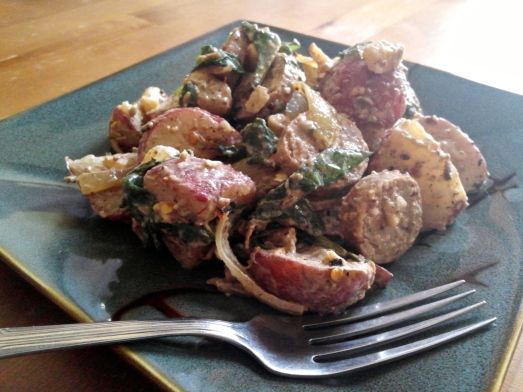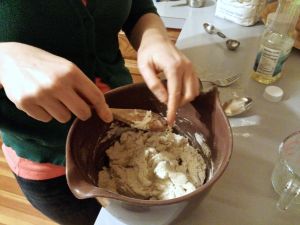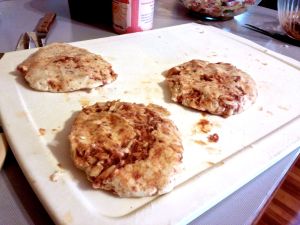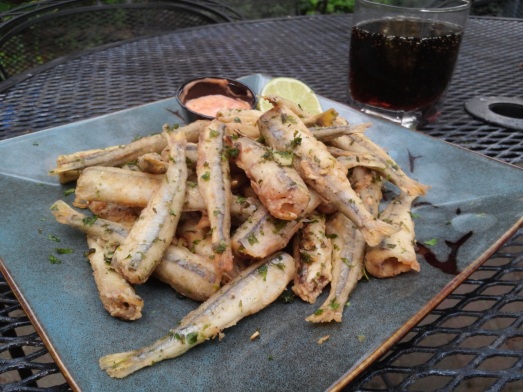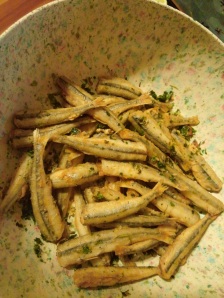A fellow blogger that I’ve just begun following recently posted a winter potato salad that is different than most potato salads especially in that it contained sliced kielbasa sausage. While I’m happy to eat vegetarian dishes, this struck me as particularly satisfying to serve as a meal, so I considered what ingredients I had on hand and came up with this idea: potato and Italian sausage salad. My version is similarly of the season in that today is a cold, snowy New England day… the sort that dissuades you from running to the market for just the right ingredients.
For this salad, you’ll need the following ingredients:
- red potatoes, about 8 large, quartered or smaller (bite-sized)
- Italian sausages, 3 sweet or hot, fresh (or uncooked from frozen)
- yellow onion, 1 medium
- baby spinach leaves, a few hands-full, fresh
- Parmiagiano-Reggiano or other hard Italian cheese, cut into tiny pieces (about 1/4 inch cubes) or coarsely grated
and, for the dressing:
- mayonnaise
- olive oil
- balsamic vinegar
- fennel seed
- black pepper
- red pepper flakes (optional)
- oregano (sparingly to taste)
- Dijon mustard
- apple cider vinegar
My dressing had a generous amount of fennel seed, freshly ground black pepper, and red pepper flakes.
As usual, I didn’t measure my ingredients; if you need hints on quantities, consider this recipe.

Dressing base ingredients. (Red pepper flakes, Dijon mustard, diluted with apple-cider vinegar, not shown.)
I originally meant this to be a potato salad with Italian flavors, but punched it up with Dijon mayonnaise, that of course goes quite well with sausage and potato.
To prepare:
Start by steaming the quartered potato; cook until tender. Meanwhile, cook the sausages. Mine were frozen, so I start by boiling them then, after cooked thoroughly (in a skillet of just-boiling water, over medium low heat, perhaps 20 minutes), poor out the water and brown them.
For uncooked sausages that are not frozen, you can also brown them first in a skillet, then boil them to cook through afterwards. (This latter method has the advantage of not risking the separation of fat in the casing, that sometimes results in the casing breaking and spewing hot fat all over.)
While browning the sausages in a pan, add the sliced onion and brown it as well.
When the potatoes are tender, remove from heat, but add the spinach to the steamer basket (and cover) to lightly steam the spinach.
Once all these ingredients are done, let them sit perhaps an hour to cool to approximately room temperature. This is a good time to prepare the dressing in which you’ll toss the aforementioned prepared ingredients.
Whisk the dressing ingredients in a large bowl to taste, to yield approximately 1/3 cup total; you might wish to use some water to dilute it to a consistency suitable for tossing.

A salad dressing of mayonnaise, olive oil, balsamic vinegar, fennel seed, freshly-ground black pepper.
Once cooled, toss the cooked ingredients and cheese in the dressing. I used a bowl scraper to turn and distribute the dressing ingredients.
Lastly, refrigerate the salad for a number of hours, tossing occasionally to redistribute the ingredients and dressing; also, taste test it and, if desired, add more diluted mustard, black pepper, and/or red pepper flakes. Letting the salad sit for a time also allows the fennel seeds and had Italian cheese to soften slightly before serving.
I removed this salad from the refrigerator for an hour or so and served it at about temperature for dinner.
It’s an unusual “meat and potatoes” meal, but perfectly satisfying all on its own!
Here are some recipes you might like; the first inspired me here and the other is a favorite from Mark Bittman:
- A Winter Potato Salad (ChefMimiBlog.com)
- Roasted Sweet Potato Salad with Black Beans and Chili Dressing (NYTimes.com)
Thanks for the inspirational recipe, Mimi! :)






